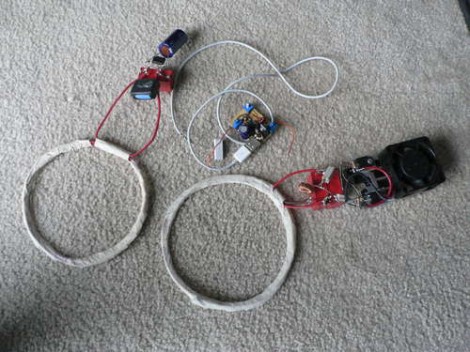
Despite the obvious use of a lot of wire, this project is actually a wireless charging system. [Jared] built it as a way to explore the concepts behind transferring power inductively. Alternating current on one of the white coils induces current on the other. This is then rectified, and regulated for use as a 5V charger. In this case it powers his iPod, but any USB device should work with the setup.
The transmitter uses the power supply from an old laptop as a source. Some filtering and a couple of MOSFETS are responsible for generating the AC current on the transmitting coil. The receiving coil feeds the bridge rectifier. In the writeup that voltage is fed to a 7805 regulator to provide a stable 5V output. However, in the video demo after the break [Jared] shows off the boost converter that he uses on his improved circuit. This way if the voltage drops due to poor alignment of the coils it will still be able to provide a steady output.
We’ve seen the same coil concept used to add wireless charging to cellphones too.
[via Make]
















Use the same amount of copper, drop the regulator to 3V and squeeze it into a wireless mouse … never need batteries
I should ammend that it should only charge when the computer is idle, maybe turn on while the screensave is on? That way the charger wont interfear with the RF
Why use batteries? Just power the thing wirelessly…
And then you can make a nice mouse pad which has the Tx coil! That would be very cool. I have a horrible little wireless mouse Maybe I will give that a go. Could do some tests to see if it would interfere with the RF.
I actually bought a wireless mouse that had such a system.
I got it at Fry’s Electronics 2 years ago and it was dirt cheap (something like 20 bucks).
I don’t remember the model number but I believe it was sold under the “Inland” noname brand.
It worked pretty well as long as your didn’t run off the powered mousepad.
I always thought it would be very cool to build a charging station using this technology to power an aeroquad/quadcopter or other RC.
What kinda distance can you charge at? Could you wirelessly power an aeroquad?
MIT did 2 meters at 60W a few years back:
http://www.sciencemag.org/content/317/5834/83.full.pdf?ijkey=94ff.Ay4jRMqU&keytype=ref&siteid=sci
The problem is you run into the inverse square law very quickly, making large distances very impractical.
what about using laser encoded magnetic power to power long distant and i mean long distant i.e in a strait
line its probably like using solar wind power to send a solar ship forward into space
what would happen if you point a geiger counter at this
Could you take the receiving section and place it near a power line and pickup power from it?
Nice for proof of concept, but as is with all similar projects are, but a long ways from being day to day practical. Need to select a frequency so the required receiver can be made much smaller than they are now. Personally I’d settle for a drop in charging base being made available by the manufacturer for less than a mint.
Could just hack the inductive charging system used by all electric rechargeable toothbrushes for the past several years.
Somewhere along the line someone in government regulation convinced themselves 2 or 3 volts at a very tiny current on bare contacts was an electrocution hazard and forced the industry of rechargeable teethbrushes (you use em on your teeth, not just one tooth!) to change to induction systems.
Did anyone ever die from a rechargeable toothbrush in the 1970’s or 1980’s?
The question is that you have open contacts in a device that sits in your bathroom, where, if the transformer of the device is broken, has a flaw or gets water into it, may pass on the line voltage to the socket of your toothbrush.
Great. This is exactly i don’t want to do when i do have pluggable cable, instead, i will try to power airship just by using Tesla coil, as if i were at Mars. LOL.
The instructable claims 3Amps at 12V….
Thats 36W to charge a 2.5W (5V @500ma) device, does anyone think this is ridiculous? thats less than 7% efficient.
I’ve just completed my University project which was making a wireless charging system, and I was achieving up to 47% efficient.
Assuming 3 hours charging a day, thats 36KWH wasted power…..
*36KWH a year
I did something similar a few years back:
http://www.instructables.com/id/Low-Power-Wireless-Charging/
The efficiency is garbage, the range sucks, and all that copper wire is expensive. But it’s neat :)
Hi, excellent post. This set me thinking, what if you could have a coil perfectly resonant to say 50 or 60 of the mains supply. All you’d need to do to charge any usb device is place the coil near any mains carrying cable. Free electricity anyone? Am I way of the mark or could it be done?
Coreless inductive power transfer is an exercise in seeing how much electricity can be wasted. Adding ferrite cores (or even simple pieces of iron or steel) would allow for a much smaller set of coils and much more efficient power transfer.